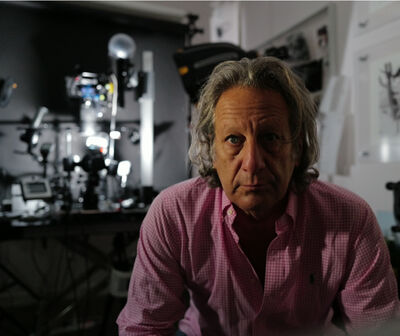Switzerland: St. Moritz
Jul 14, 2021 15:28:38 #
St. Moritz (also German: Sankt Moritz, Romansh: About this soundSan Murezzan , Italian: San Maurizio, French: Saint-Maurice) is a high Alpine resort town in the Engadine in Switzerland, at an elevation of about 1,800 metres (5,910 ft) above sea level. It is Upper Engadine's major town and a municipality in the district of Maloja in the Swiss canton of Graubünden.
St. Moritz lies on the southern slopes of the Albula Alps below the Piz Nair (3,056 m or 10,026 ft) overlooking the flat and wide glaciated valley of the Upper Engadine and eponymous lake: Lake St. Moritz. It hosted the Winter Olympics in 1928 and 1948.
Votive offerings, swords, and needles from the Bronze Age found at the base of the springs in St. Moritz indicate that the Celts had already discovered them. St. Moritz is first mentioned around 1137–39 as ad sanctum Mauricium. The village was named after Saint Maurice, an early Christian saint from southern Egypt said to have been martyred in 3rd century Roman Switzerland while serving as leader of the Theban Legion.
Pilgrims traveled to Saint Mauritius, often to the church of the springs, where they drank from the blessed, bubbling waters of the Mauritius springs in the hopes of being healed. In 1519, the Medici pope, Leo X, promised full absolution to anyone making a pilgrimage to the church of the springs. In the 16th century, the first scientific treatises about the St. Moritz mineral springs were written. In 1535, Paracelsus, the great practitioner of natural remedies, spent some time in St. Moritz.
St. Moritz has been a resort for winter sport vacations since the 19th century. Students from Oxford and Cambridge went there to play each other; the predecessor of the recurring Ice Hockey Varsity Match was a bandy match played in St. Moritz in 1885. St. Moritz was the host city for the Winter Olympic Games in 1928 and 1948, one of three cities to host twice, along with Innsbruck, Austria and Lake Placid in the United States. It also hosted the FIS Alpine World Ski Championships in 1934, 1974, 2003, and 2017.
St. Moritz is the highest town in the country with a railway station. St. Moritz railway station is situated in the centre of the town, near the lakeshore and at the bottom of Via Serlas. It is operated by the Rhaetian Railway, and is the terminus that railway's Albula and Bernina lines. The Glacier Express and Bernina Express trains stop at St. Moritz.
Near the railway station is an important Swiss PostBus stop.
The St. Moritz–Corviglia funicular links St. Moritz with the Corviglia summit and ski area. https://en.wikipedia.org/wiki/St._Moritz
From the website: https://www.myswitzerland.com/en-se/destinations/st-moritz/
"St. Moritz is more than just a holiday resort. It was also the birthplace of Alpine winter tourism (in 1864) and has twice hosted the Winter Olympics. Nevertheless, St. Moritz first became famous thanks to its mineral springs, which were discovered 3,000 years ago and established the town as a summer spa resort early on.
St. Moritz, which is in the Upper Engadine, at an elevation of 1,856 m, boasts plenty of sunny days. It was exactly this sun that was legally protected as the emblem of St. Moritz in 1930. St. Moritz was often ahead of the times - for example, the first electric light went on at Christmastime in 1878, the first golf tournament in the Alps took place here, in 1889 and one of the first ski lifts in Switzerland began running in 1935.
Guests from all over the world appreciate the modern Alpine lifestyle, characterised by top-class restaurants that can satisfy gourmet demands even by the side of the slopes, hotels that set standards in every category, and events of international calibre. The Via Serlas guarantees great shopping in a small space, though you can also find local specialities like the famous Engadine nut tart just around the corner.
Sights such as the leaning tower, a remnant of the Mauritius Church from around 1500, or the Segantini Museum, offer a change from the life of luxury and the jet set.
Winter
154 years ago, the hotelier Johannes Badrutt made a bold bet with his English summer guests, promising them mild Engadine sunshine in mid-winter. Badrutt won the bet and St. Moritz went on to become one of the world's most exceptional winter sports resorts.
For winter sports enthusiasts there are 350 kilometres of pistes with a state-of-the-art infrastructure in the surrounding area. St. Moritz's 'house mountain', the Corviglia, boasts the steepest start slope in Switzerland with the Piz Nair Wall's 100 per cent vertiginous drop. Toboggan riders plunge down the icy run which is one of the oldest natural ice bob runs in the world. For winter hikers there are 150 km of winter walking trails and for cross-country skiers there is a track network of about 200 km. The snowboard fun park, curling and altitude training are just some of the other winter sports facilities.
As well as traditional hiking and mountain biking, guests can also try their hand at sailing, rowing, windsurfing, kitesurfing, tennis, minigolf or horse riding. The Ludains Ice Arena is also open to skaters throughout the summer, while golfers will find an Alpine paradise with four courses in the surrounding area. Romantic carriage rides around the lake, through the Staz forest or the grand town itself are among the highlights of a stay in St. Moritz. Mountaineers also have plenty of options in Upper Engadine and there are 17 climbing gardens of various difficulty levels to complete the facilities.
Summer
Although it received some visitors during the summer, the origins of the winter resort only date back 157 years ago to September 1864, when St. Moritz hotel pioneer Caspar Badrutt made a wager with four British summer guests: they should return in winter and, in the event that the village was not to their liking, he would reimburse their travel costs. If they were to find St. Moritz attractive in winter, he would invite them to stay as his guests for as long as they wished. This marked not only the start of winter tourism in St. Moritz but also the start of winter tourism in the whole of the Alps. The first tourist office in Switzerland was established the same year in the village. St. Moritz developed rapidly in the late nineteenth century; the first electric light in Switzerland was installed in 1878 at the Kulm Hotel, and the first curling tournament on the continent was held in 1880. The first European Ice-Skating Championships were held at St. Moritz in 1882 and first golf tournament in the Alps held in 1889. The first bob run and bob race was held in 1890. By 1896, St. Moritz became the first village in the Alps to install electric trams and opened the Palace Hotel. A horse race was held on snow in 1906, and on the frozen lake the following year. The first ski school in Switzerland was established in St. Moritz in 1929.
St. Moritz hosted the 1928 Winter Olympics—the stadium still stands today—and again in 1948. It has hosted over 20 FIBT World Championships, four FIS Alpine World Ski Championships (1934/1974/2003/2017) and over 40 Engadin Skimarathons since 1969. It has also hosted many other events since, including some unlikely ones on the frozen lake in the 1970s and 1980s such as a golf tournament, (1979), a snow polo tournament (every year in January starting in 1985) and Cricket on Ice (1989). St. Moritz has also been the venue for many Sailing and Windsurfing World Championships.
Since the early 1980s St. Moritz is also promoted and known as Top of the World. The expression was registered as a trademark by the tourist office in 1987.
We arrived in St. Moritz after our scenic ride up to the Maloja Pass and checked into the luxurious Grand Kempinski Des Bains Hotel. I hope you enjoy these images, some of which were taken from our hotel room balcony and some from a stroll around town. Please try the downloads.
Mark
St. Moritz lies on the southern slopes of the Albula Alps below the Piz Nair (3,056 m or 10,026 ft) overlooking the flat and wide glaciated valley of the Upper Engadine and eponymous lake: Lake St. Moritz. It hosted the Winter Olympics in 1928 and 1948.
Votive offerings, swords, and needles from the Bronze Age found at the base of the springs in St. Moritz indicate that the Celts had already discovered them. St. Moritz is first mentioned around 1137–39 as ad sanctum Mauricium. The village was named after Saint Maurice, an early Christian saint from southern Egypt said to have been martyred in 3rd century Roman Switzerland while serving as leader of the Theban Legion.
Pilgrims traveled to Saint Mauritius, often to the church of the springs, where they drank from the blessed, bubbling waters of the Mauritius springs in the hopes of being healed. In 1519, the Medici pope, Leo X, promised full absolution to anyone making a pilgrimage to the church of the springs. In the 16th century, the first scientific treatises about the St. Moritz mineral springs were written. In 1535, Paracelsus, the great practitioner of natural remedies, spent some time in St. Moritz.
St. Moritz has been a resort for winter sport vacations since the 19th century. Students from Oxford and Cambridge went there to play each other; the predecessor of the recurring Ice Hockey Varsity Match was a bandy match played in St. Moritz in 1885. St. Moritz was the host city for the Winter Olympic Games in 1928 and 1948, one of three cities to host twice, along with Innsbruck, Austria and Lake Placid in the United States. It also hosted the FIS Alpine World Ski Championships in 1934, 1974, 2003, and 2017.
St. Moritz is the highest town in the country with a railway station. St. Moritz railway station is situated in the centre of the town, near the lakeshore and at the bottom of Via Serlas. It is operated by the Rhaetian Railway, and is the terminus that railway's Albula and Bernina lines. The Glacier Express and Bernina Express trains stop at St. Moritz.
Near the railway station is an important Swiss PostBus stop.
The St. Moritz–Corviglia funicular links St. Moritz with the Corviglia summit and ski area. https://en.wikipedia.org/wiki/St._Moritz
From the website: https://www.myswitzerland.com/en-se/destinations/st-moritz/
"St. Moritz is more than just a holiday resort. It was also the birthplace of Alpine winter tourism (in 1864) and has twice hosted the Winter Olympics. Nevertheless, St. Moritz first became famous thanks to its mineral springs, which were discovered 3,000 years ago and established the town as a summer spa resort early on.
St. Moritz, which is in the Upper Engadine, at an elevation of 1,856 m, boasts plenty of sunny days. It was exactly this sun that was legally protected as the emblem of St. Moritz in 1930. St. Moritz was often ahead of the times - for example, the first electric light went on at Christmastime in 1878, the first golf tournament in the Alps took place here, in 1889 and one of the first ski lifts in Switzerland began running in 1935.
Guests from all over the world appreciate the modern Alpine lifestyle, characterised by top-class restaurants that can satisfy gourmet demands even by the side of the slopes, hotels that set standards in every category, and events of international calibre. The Via Serlas guarantees great shopping in a small space, though you can also find local specialities like the famous Engadine nut tart just around the corner.
Sights such as the leaning tower, a remnant of the Mauritius Church from around 1500, or the Segantini Museum, offer a change from the life of luxury and the jet set.
Winter
154 years ago, the hotelier Johannes Badrutt made a bold bet with his English summer guests, promising them mild Engadine sunshine in mid-winter. Badrutt won the bet and St. Moritz went on to become one of the world's most exceptional winter sports resorts.
For winter sports enthusiasts there are 350 kilometres of pistes with a state-of-the-art infrastructure in the surrounding area. St. Moritz's 'house mountain', the Corviglia, boasts the steepest start slope in Switzerland with the Piz Nair Wall's 100 per cent vertiginous drop. Toboggan riders plunge down the icy run which is one of the oldest natural ice bob runs in the world. For winter hikers there are 150 km of winter walking trails and for cross-country skiers there is a track network of about 200 km. The snowboard fun park, curling and altitude training are just some of the other winter sports facilities.
As well as traditional hiking and mountain biking, guests can also try their hand at sailing, rowing, windsurfing, kitesurfing, tennis, minigolf or horse riding. The Ludains Ice Arena is also open to skaters throughout the summer, while golfers will find an Alpine paradise with four courses in the surrounding area. Romantic carriage rides around the lake, through the Staz forest or the grand town itself are among the highlights of a stay in St. Moritz. Mountaineers also have plenty of options in Upper Engadine and there are 17 climbing gardens of various difficulty levels to complete the facilities.
Summer
Although it received some visitors during the summer, the origins of the winter resort only date back 157 years ago to September 1864, when St. Moritz hotel pioneer Caspar Badrutt made a wager with four British summer guests: they should return in winter and, in the event that the village was not to their liking, he would reimburse their travel costs. If they were to find St. Moritz attractive in winter, he would invite them to stay as his guests for as long as they wished. This marked not only the start of winter tourism in St. Moritz but also the start of winter tourism in the whole of the Alps. The first tourist office in Switzerland was established the same year in the village. St. Moritz developed rapidly in the late nineteenth century; the first electric light in Switzerland was installed in 1878 at the Kulm Hotel, and the first curling tournament on the continent was held in 1880. The first European Ice-Skating Championships were held at St. Moritz in 1882 and first golf tournament in the Alps held in 1889. The first bob run and bob race was held in 1890. By 1896, St. Moritz became the first village in the Alps to install electric trams and opened the Palace Hotel. A horse race was held on snow in 1906, and on the frozen lake the following year. The first ski school in Switzerland was established in St. Moritz in 1929.
St. Moritz hosted the 1928 Winter Olympics—the stadium still stands today—and again in 1948. It has hosted over 20 FIBT World Championships, four FIS Alpine World Ski Championships (1934/1974/2003/2017) and over 40 Engadin Skimarathons since 1969. It has also hosted many other events since, including some unlikely ones on the frozen lake in the 1970s and 1980s such as a golf tournament, (1979), a snow polo tournament (every year in January starting in 1985) and Cricket on Ice (1989). St. Moritz has also been the venue for many Sailing and Windsurfing World Championships.
Since the early 1980s St. Moritz is also promoted and known as Top of the World. The expression was registered as a trademark by the tourist office in 1987.
We arrived in St. Moritz after our scenic ride up to the Maloja Pass and checked into the luxurious Grand Kempinski Des Bains Hotel. I hope you enjoy these images, some of which were taken from our hotel room balcony and some from a stroll around town. Please try the downloads.
Mark
Approaching St. Moritz
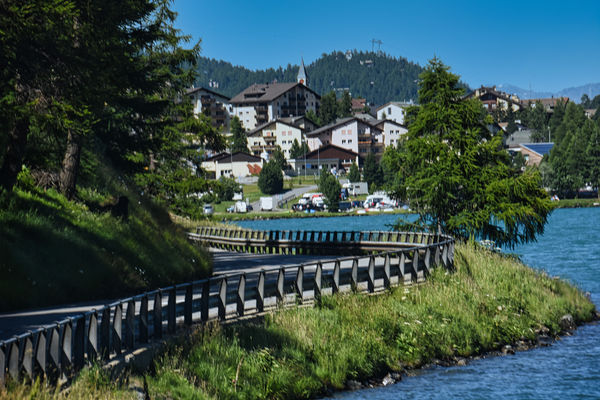
(Download)
Our hotel- The Grand Hotel Kempinski Des Bains
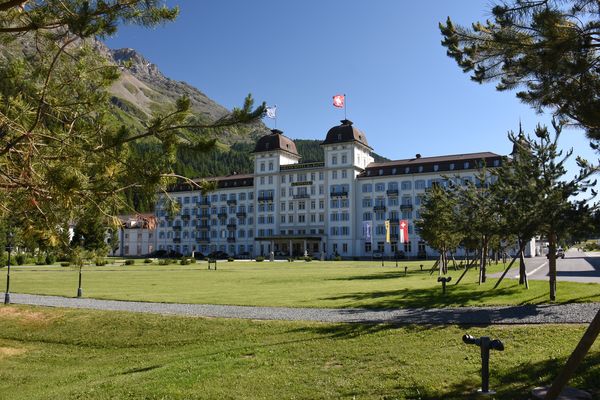
(Download)
Taken from our hotel room balcony
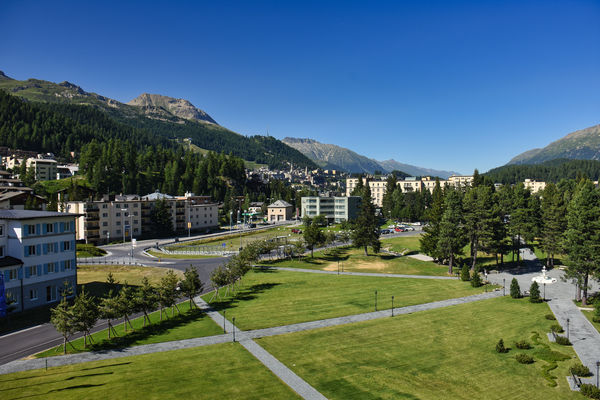
(Download)

(Download)
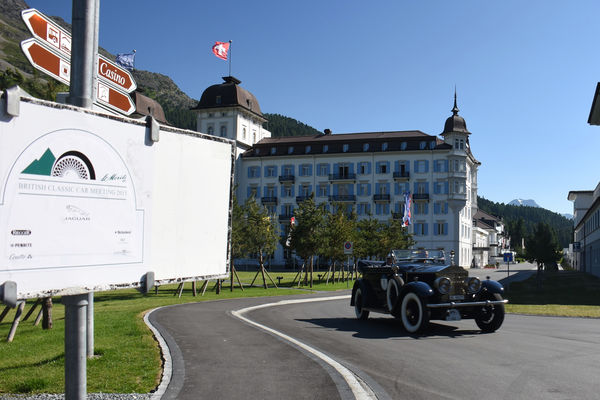
(Download)

(Download)
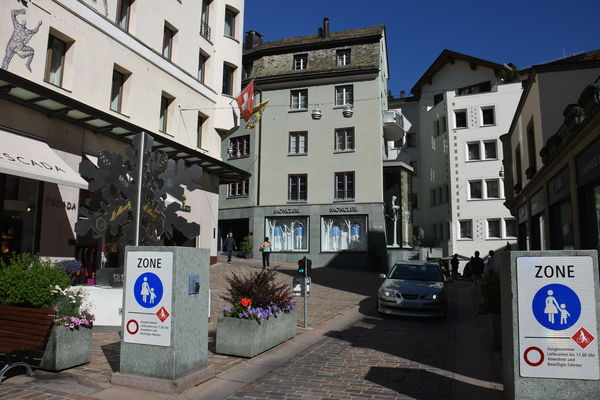
(Download)
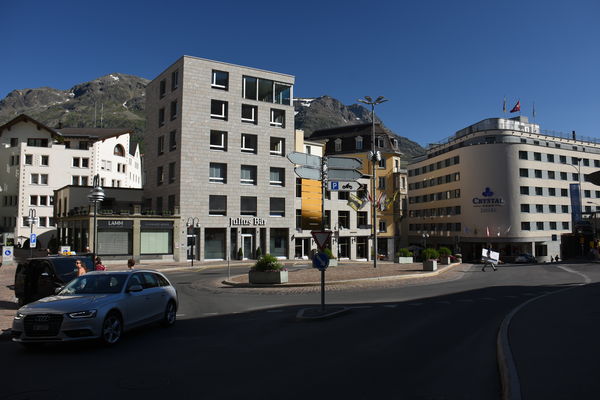
(Download)
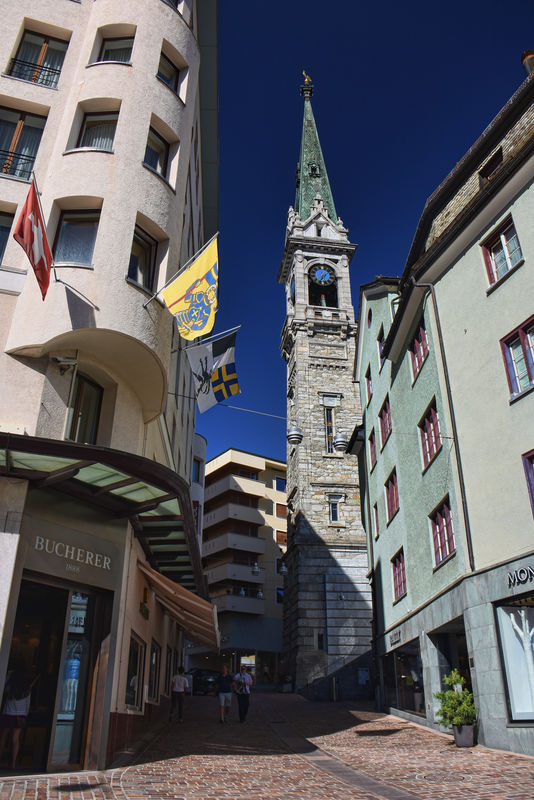
(Download)
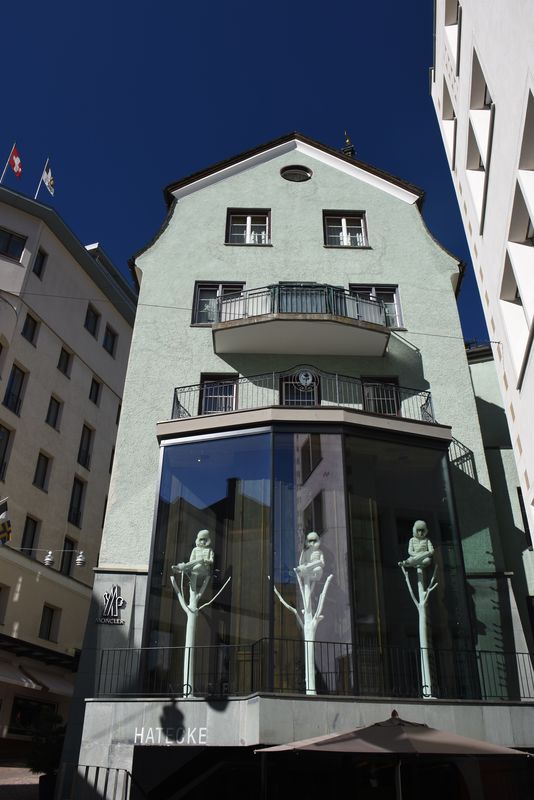
(Download)
Jul 14, 2021 15:35:03 #
Jul 14, 2021 15:44:56 #
Jul 14, 2021 15:45:55 #
Jul 14, 2021 15:47:08 #
I spent a week nearby and hiked to the top of that Ski Area. There is a circular shaped restaurant and BAR!!!. A very welcome amenity. I can attest that the start of that slope seems nearly vertical. One gets the sense that if a skier leaned too far over his tips, he'd tumble.
This was, for me, the most beautiful part of Switzerland I got to see during a month long trip back at the end of the last Century.
This was, for me, the most beautiful part of Switzerland I got to see during a month long trip back at the end of the last Century.
Jul 14, 2021 15:53:30 #
srfmhg wrote:
St. Moritz (also German: Sankt Moritz, Romansh: Ab... (show quote)
Excellent images and magnificent scenery 💫⭐🏆⭐💫
Jul 14, 2021 16:00:56 #
srfmhg wrote:
St. Moritz (also German: Sankt Moritz, Romansh: Ab... (show quote)
Another excellent set Mark. A beautiful place and it looks like you also got to see some beautiful cars in addition to the scenery. It looks like a Rolls Royce in photo number 5 and a Ferrari F430 in numbeer 6.
Jul 14, 2021 16:23:13 #
Jul 14, 2021 16:31:42 #
Jul 14, 2021 16:38:06 #
I love St. Moritz. Beautiful part of the world. Thank you for the detailed tour and history. If you have time, approx 90 km south is Lake Como. On that lake is a wonderful restaurant called Isola di Comacina. Well worth the drive. https://www.comacina.it/ Call first and take cash.
Jul 14, 2021 16:42:14 #
Jul 14, 2021 17:47:10 #
Jul 14, 2021 17:47:57 #
captivecookie wrote:
Ah, your travels continue to benefit us all. Thanks.
You're most welcome Cookie. Glad to have you along!
Jul 14, 2021 17:48:35 #
angler wrote:
Excellent set Mark.
Thanks so much Jim. Always great to hear from you!
Jul 14, 2021 17:50:45 #
Photocraig wrote:
I spent a week nearby and hiked to the top of that Ski Area. There is a circular shaped restaurant and BAR!!!. A very welcome amenity. I can attest that the start of that slope seems nearly vertical. One gets the sense that if a skier leaned too far over his tips, he'd tumble.
This was, for me, the most beautiful part of Switzerland I got to see during a month long trip back at the end of the last Century.
This was, for me, the most beautiful part of Switzerland I got to see during a month long trip back at the end of the last Century.
Thanks very much for the info Craig. As a retired skier, I can appreciate that. Personally, I stuck to the blue runs!
If you want to reply, then register here. Registration is free and your account is created instantly, so you can post right away.







